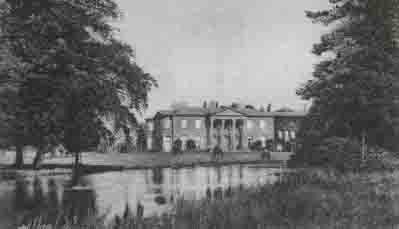Willingham House, or Willingham Hall as it was alternatively known, was a country house constructed in 1790 and eventually demolished on the 7th June 1976; built for the Boucherett family, it replaced their previous home which had been closer to the village of North Willingham.
The family's original home had been purchased in 1674 when Florentine Tenturier bought the manors of both North Willingham and nearby Ludford off the previous owner Lawrence Caldwell; Tenturier's daughter then married into the Boucherett line by wedding Matthew Boucherett, thereby forming the connection between the Boucherett family and the village that would continue even after the line died out and their descendents, the Wrights, continued to live at Willingham House.
It is believed that Willingham House was designed by Robert Mitchell, and its distinctive neo-classical style is unique in Lincolnshire; the four pillars directly in front of the main entrance resemble those of Market Rasen's Centenary Methodist Chapel, also built in the neo-classical style.
Although the Boucheretts owned the house from the time it was built in 1790 to the death of the last Boucherett, Emelia Jessie, in 1905, they did not reside there for the first half of the 1800s, returning only after 1850. In the intervening years in between they let the house to tenants such as Edwin Giles Howard in the 1830s, whose father-in-law was Edward Heneage. The Heneages were also an established family, this time from Hainton, who in the past had also had other connections with North Willingham. It was for example a Mr. Heneage who, along with a Mr. Maddison, was sent to King Henry VIII with a letter of complaint at the time of the Lincolnshire Rising.
Willingham House's ownership remained consistent, since it stayed in the Boucherett family until their line discontinued, whereupon it passed to their close descendents, the Wrights. However, its different inhabitants can clearly be separated into four distinct time periods:
Firstly, after its construction in 1790 those occupying Willingham House were the same family who owned it, the Boucheretts, seeing as it was built on the orders of the second Ayscough Boucherett. In 1815 he died however, instantly killed when his curricle overturned at the base of Willingham Hill.
After the initial inhabitation by the second Ayscough Boucherett, Willingham House was then let to tenants and in the 1830s these were the Howards, who by marriage were related to the Heneages of Hainton. This period of occupation by tenants continued until the 1850s when the Boucheretts returned to Willingham House.
Once the Boucheretts moved back into their home it remained their place of residence until the line disappeared at the turn of the 20th century with the death of Emelia Jessie Boucherett. She and her sister Louisa inherited the house following the death of the third Ayscough Boucherett in 1857 and his last surviving son in 1877. Since his other two sons had died young, one in 1832 at the age of 15, he had no more male heirs and the estates passed to the two sisters.
The final period is even more distinguishable than the preceding three, because after Emelia Jessie Boucherett's death in 1905 the estate's owners no longer bore the Boucherett name, seeing as that line had now vanished. Instead Willingham House passed to the Barnes of Sotterly, with these being the next descendents of the Boucheretts due to an earlier marriage with one of the Boucherett daughters. The final occupants of the house were the Wrights, also related to the Boucheretts. Of these the first, Charles Wright of North Willingham, died on 10th December 1926 when his gun was triggered by accident in Willingham House, but his death was preceded by that of both of his sons, for Major Robert Wright and Lieutenant Charles Wright of the 1/1st Lincolnshire Yeomanry both died on a troop ship in Palestine on the 28th November 1917. Charles Wright's wife Isabella Margarita lived until the 10th July 1942, and a marble tablet honoring both her and her husband was placed in the church by their remaining children. The two wooden crosses from Palestine for both Major Robert Wright and Lieutenant Charles Wright were also brought back and now stand in the chancel of St. Thomas' church.

Links: